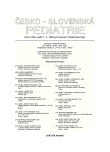Retrospektivní analýza růstu u tumorů hypotalamo-hypofyzární oblasti
Retrospective Analysis of Growth in Tumors of Hypothalamus-Hypophysis Region
Objective:
Analysis of symptoms leading to the diagnosis of brain tumor in hypothalamushypophysis region and the occurrence of growth retardation according to retrospective analysis of growth.
Patients and methods:
The authors analyzed a group of 70 patients (37 girls and 33 boys) at the mean age of 9.7±3.8 (0.8–17) years with tumors in hypothalamic-hypophysis region: 32 children with craniopharyngioma (13 girls, 19 boys), 18 children with astrocytoma (14 girls, 4 boys) and 20 children with germinal tumors (10 boys and 10 girls).
Results:
Although the growth retardation was the reason for examination in 6% of children only (4), the retrospective analysis established growth retardation in 51.4% of children (36/70).
The height below 3rd percentile was observed in 27.1% of children (19/70). In the cases suffering from craniopharyngioma the growth retardation occurred in 68.6% (22/32) patients, the growth below the 3rd percentile being found in 37.5% (12/32) children. The children with germinal tumor were affected by growth retardation in 55 % of cases (11/20) and in 10 of them (50%) the growth was below the 3rd percentile. In patients affected by astrocytoma the growth retardation was established in 16% of children (3/19), while the growth below the 3rd percentile was absent in all of them. The growth retardation related to the hereditary potential was apparent in all groups.
The mean height of the parents against the height of the patient at the time of diagnosis establishment proved to be -0.01±0.94 SD vs. -1.7±1.3 SD in the children with craniopharyngioma (p<0.001), -0.29±0.8 SD vs. -1.67±1.66 SD in children with germinal tumors (p<0.01) and 0±0.78 vs. -0.68±0.95 SD in children with astrocytoma (p<0.05). The decrease of growth rate in the patients with growth retardation was detectable at least two years before diagnosis of the tumors (range 2–8 years).
Conclusion:
A careful monitoring of growth of the child and a comparison with the height with the predictive range according to the parents made in possible to diagnose the tumor in our cohort of children at an earlier time in more than 50% of patients.
Key words:
tumors of hypothalamo-hypophysis region, retrospective analysis of growth
Autoři:
S. Koloušková 1; D. Zemková 1; M. Cháňová 2; J. Mališ 2; M. Šnajderová 1
Působiště autorů:
Pediatrická klinika 2. LF UK a FN Motol, Praha
přednosta prof. MUDr. J. Vavřinec, CSc.
1; Klinika dětské hematologie a onkologie 2. LF UK a FN Motol, Praha
přednosta prof. MUDr. J. Starý, DrSc.
2
Vyšlo v časopise:
Čes-slov Pediat 2005; 60 (6): 345-348.
Kategorie:
Původní práce
Souhrn
Cíl práce:
Analýza symptomů, které vedly k diagnóze mozkového tumoru hypotalamo-hypofyzární oblasti a výskyt růstové retardace podle retrospektivní analýzy růstu.
Pacienti a metodika:
Byla analyzována skupina 70 pacientů (37 dívek a 33 chlapců), průměrného věku 9,7±3,8 (0,8–17) let s tumorem hypotalamo-hypofyzární oblasti: 32 dětí s kraniofaryngeomem (13 dívek, 19 chlapců), 18 dětí s astrocytomem (14 dívek, 4 chlapci) a 20 dětí s germinálním tumorem (10 dívek a 10 chlapců).
Výsledky:
Ačkoliv růstová retardace byla důvodem k vyšetření pouze u 6 % dětí (4), retrospektivní analýzou byla růstová retardace zjištěna u 51,4 % dětí (36/70). Výšku pod 3. percentilem mělo 27,1 % dětí (19/70). U kraniofaryngeomu se růstová retardace vyskytovala u 68,8 % (22/32) pacientů, z toho růst pod 3. percentilem byl u 37,5 % (12/32) dětí. Děti s germinálním nádorem měly růstovou retardaci přítomnou u 55 % případů (11/20) a u 10 z nich (50 %) byl růst pod 3. percentilem.
U pacientů s astrocytomem byla růstová retardace prokázána u 16 % dětí (3/19), růst pod 3. percentilem nemělo žádné dítě. Opoždění růstu proti dědičnému potenciálu bylo patrné u všech skupin.
Střední výška rodičů oproti výšce pacientů při diagnóze byla u dětí s kraniofaryngeomem -0,01±0,94 SD vs. -1,7±1,3 SD (p<0,001), u dětí s germinálním tumorem -0,39±0,8 SD vs. -1,67±1,66 SD (p <0,01), u dětí s astrocytomem 0±0,78 vs -0,68±0,95 SD (p <0,05). U pacientů s růstovou retardací bylo zpomalování růstové rychlosti zjistitelné minimálně 2 roky před diagnózou tumoru (rozmezí 2–8 let).
Závěr:
Pečlivým monitorováním růstu dítěte a porovnáním jeho výšky s prediktivním pásmem podle rodičů bylo možno v naší skupině diagnostikovat mozkový tumor dříve u více než 50 % nemocných.
Klíčová slova:
tumory hypotalamo-hypofyzární oblasti, retrospektivní analýza růstu
Štítky
Neonatologie Pediatrie Praktické lékařství pro děti a dorostČlánek vyšel v časopise
Česko-slovenská pediatrie

2005 Číslo 6
- Horní limit denní dávky vitaminu D: Jaké množství je ještě bezpečné?
- Isoprinosin je bezpečný a účinný v léčbě pacientů s akutní respirační virovou infekcí
- Syndrom Noonanové: etiologie, diagnostika a terapie
Nejčtenější v tomto čísle
- Vztah sexuální a skeletální maturace a hodnocení biologického věku v pediatrii
- Růst a finální výška dívek s centrální předčasnou pubertou po dlouhodobé léčbě depotním agonistou gonadoliberinu
- Predikce a prevence diabetes mellitus 1. typu
- Homozygotní forma familiárního defektu apo B-100 (FDB) u sedmileté dívky
